Lessons I Learned from My 17 Years as ISB President
 hood-price.isbscience.org/2017/12/28/lee-hood-lessons-learned/
hood-price.isbscience.org/2017/12/28/lee-hood-lessons-learned/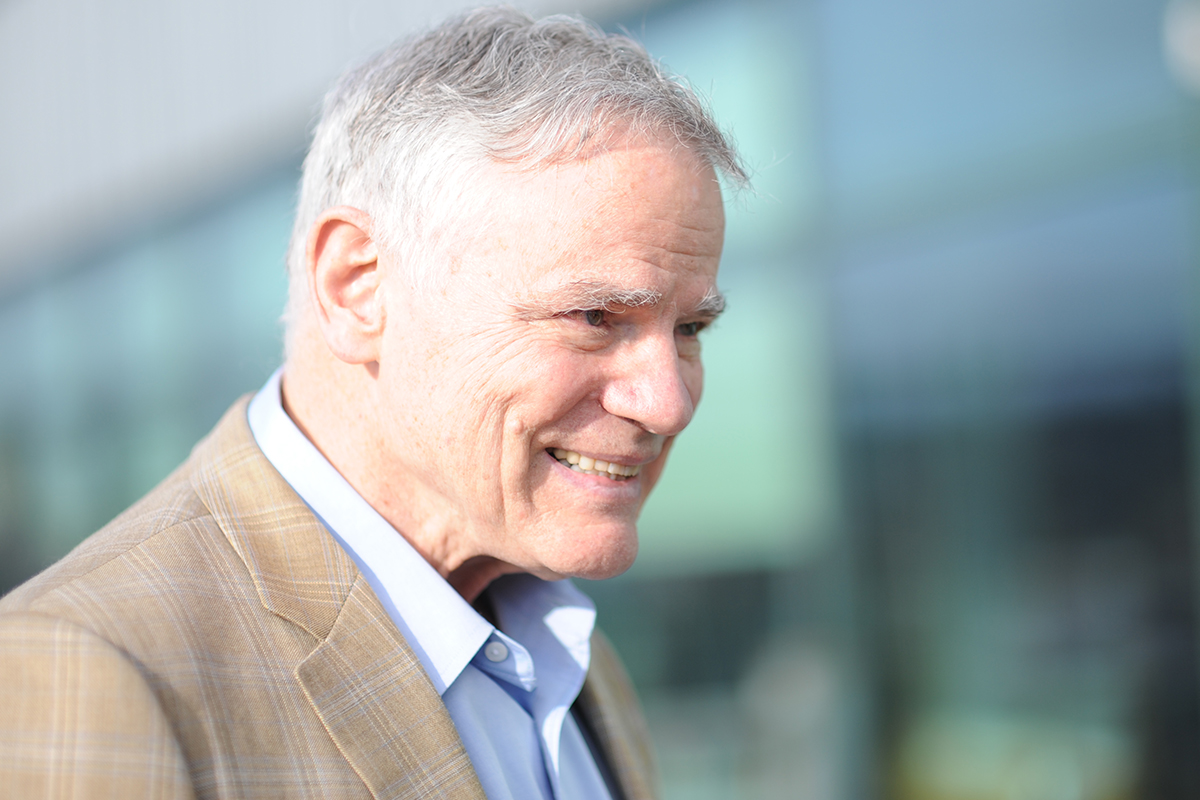
Dr. Lee Hood, above, co-founded Institute for Systems Biology (ISB) in 2000. Hood has stepped down as president of ISB to continue his transformational work as senior vice president and chief science officer of Providence St. Joseph Health, chief strategy officer and professor at ISB, and co-leader of the Hood-Price Lab.
By Dr. Lee Hood
I step down as president of the Institute for Systems Biology (ISB) on January 1, 2018. As I think about my 17-year term as president, I am astounded at how much I have learned, not only about science but also about, among other things, what it takes to build a unique, world-class institution.
The Beginnings
I came to ISB from 30 years in academia. For 22 years, I was a faculty member of Biology at Caltech, the last 10 years as chair of the department. Following Caltech, I spent eight years at the University of Washington (UW) Medical School as founder and chair of the Department of Molecular Biotechnology (MBT) — the first cross-disciplinary biology department to my knowledge in the world.
I resigned from the UW in December 1999 to launch ISB in mid-2000 — the first institute dedicated to the nascent discipline that I coined as “systems biology.”
I had been thinking about biological complexity for decades. My colleagues and I began to create new technologies and strategic approaches to address this complexity. We developed at Caltech and MBT automated biological instrumentation that led to high throughput biological measurements and the data that initiated the big data era for biology. The automated DNA sequencer enabled the human genome program. I played a role in advocating and executing this program, commercializing a genomic approach to drug discovery (Darwin, Inc.), and applying the fruits of genomic discovery to human medicine. The human genome program was biology’s first big science project and it transformed many different aspects of biology and medicine, as well as our understandings of Darwinian evolution and human migrations.
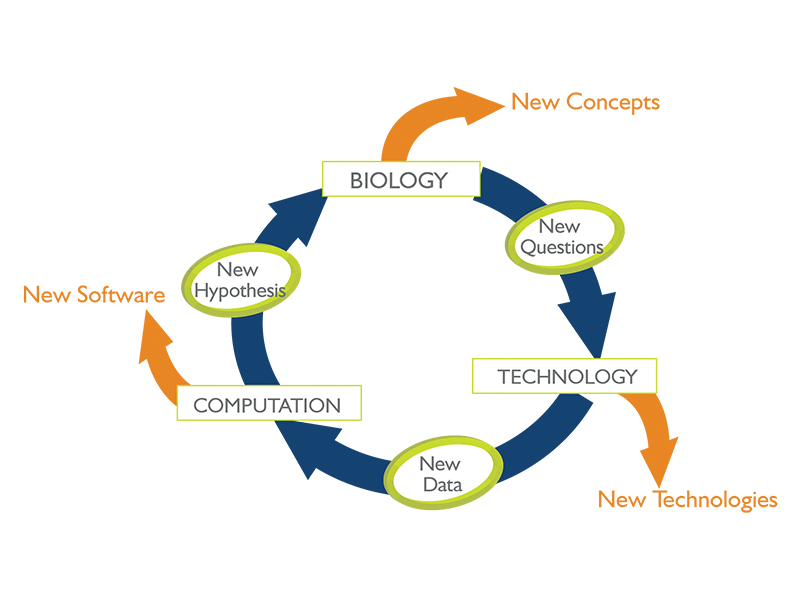 I started to conceptualize systems biology in the late 1980s and even wrote several unsuccessful grants on this topic at that time. Over the next decade, my thinking matured about how to define systems biology and employ it to unravel biological complexity in a global or holistic manner quite distinct from the traditional approach of studying biology one gene or one protein at a time.
I started to conceptualize systems biology in the late 1980s and even wrote several unsuccessful grants on this topic at that time. Over the next decade, my thinking matured about how to define systems biology and employ it to unravel biological complexity in a global or holistic manner quite distinct from the traditional approach of studying biology one gene or one protein at a time.
The bureaucracy of a large state university made it difficult to introduce this new discipline — requiring the integration of biology, technology and computation, which was so different from the pre-existing biological disciplines. I realized that comprehensive systems biology could only emerge from a new organizational structure. So, I founded ISB with a vision of systems biology and a sense of what was required to build an appropriate research environment, a supportive culture, and scientific leadership and expertise. We started with commitments to bringing knowledge to society, maturing ISB rapidly, and achieving simplicity in administrative organization and decision making.
The Vision and Execution of Systems Biology at ISB
Systems biology takes a global and holistic approach to addressing biological complexity — where biology drives the pioneering of relevant technologies and the resulting data drive the invention of computational tools. This vision has driven the ongoing evolution of ISB. Critical elements of systems biology are:
- Cross-disciplinary research environment: Systems biology must be embedded in a cross-disciplinary environment with biologists, chemists, computer scientists, engineers, mathematicians, physicists and physicians. Our fundamental mantra is that leading-edge systems biology should drive the development of relevant technologies and these, in turn, should push the creation of the necessary computational tools for handling the relevant data (often big data). These approaches have transformed our understanding of biological complexity.
- Collaborative culture: Systems biology must have an appropriate cultural environment to foster and encourage independence, creativity, excellence, interactions, respect, passion, determined optimism (to get through the difficult times) and encouragement to think big enough to “invent the future.”
- Scientific leadership and expertise: To rapidly build an outstanding scientific environment, I recruited Alan Aderem — an excellent immunologist — and Ruedi Aebersold — a global leader in protein chemistry. The three of us were the co-founders of ISB and our combined scientific strengths and reputations quickly attracted a world-class faculty and staff. The faculty of ISB beautifully reflect the essence of systems biology — with interests in biology, medicine, technology and computation (see below).
- Transfer of knowledge to society: The transfer of knowledge to society is fundamental to ISB’s mission. We initially focused on two areas in this regard — science education for K-12 students and innovation and company creation.
- The Valerie Logan Center for Education was established to enable professional teacher training with access to high quality STEM (Science, Technology, Engineering & Math) education. We transformed K-12 science education in Seattle Schools and more recently have engaged almost half the school districts in the state in STEM education through professional teacher training.
- I had founded or co-founded eight companies, including Amgen and Applied Biosystems (ABI commercialized the four instruments my lab developed at Caltech), prior to the initiation of ISB and thus had a great deal of experience in this realm. ISB has created eight companies in its 17 years of existence — several of which have brought millions of dollars to ISB. This is a key idea — that successful innovation can bring support for basic research.
- Nimble organizational structure: ISB needed a simple administrative organization that could adapt quickly to new opportunities and could rapidly make important (and even less important) decisions.
Bringing these concepts to life at the new institute began immediately. In some areas, it was easy. In others, we debated considerably about the issues (e.g., should we have K-12 education as a central feature of ISB? Should innovation and company creation become a major pillar of ISB? One particularly vigorous debate was whether to seek grants from the Department of Defense). With some of the ideas related to systems biology and systems medicine, it turned out to be an ongoing evolution of conceptual thinking moving in different directions driven by different faculty members. The applications of systems biology to biology and medicine commenced immediately (see below).
Many new surprises and marvelous opportunities came from the creation of ISB.
Transformational Events for ISB
To put ISB in perspective, there were four major transformational events during its evolution.
- Our three moves (MBT at UW to the cramped quarters at Roosevelt in the University District in 2000; Roosevelt to North Lake Union in 2001; North Lake Union to South Lake Union in 2011) each time expanding to a larger facility which created new opportunities. Each expansion allowed us to reintegrate groups we had located at dispersed sites, enabled future growth and new infrastructure, and inspired us to recommit to the ongoing evolution of systems thinking.
- The Center for Systems Biology at ISB is one of 11 national systems-biology centers funded by the National Institute for General Medical Sciences. Established in 2006 and funded through 2017, the ISB Center provides resources for the integration of big science projects, the exploration of new scientific directions, the support of activities to create a systems biology-driven culture and the training of students at all levels. The center provided the glue that really facilitated interactions and the evolution of a systems-driven culture. John Aitchison has done a marvelous job as director.
- The strategic partnership with Luxembourg brought ISB $100 million — $20 million per year from 2008-2013 — to invent the technologies and strategies of systems biology (see below).
- In April of 2016 ISB affiliated with Providence St. Joseph Health (PSJH), the large, Seattle-based, non-profit health care system. ISB has become the research arm for PSJH and I became its chief science officer. This affiliation provides the opportunity to bring systems-driven medicine to the U.S. health care system (see below), which will transform health care to a proactive force, focused on optimizing an individual’s wellness and identifying the earliest opportunities to reverse or even prevent disease.
Launching ISB Was Challenging
We needed about $20 million to build a functional systems biology-driven infrastructure for science at ISB. Unfortunately, the institute was launched at just about the time of an enormous economic downturn. I had planned to ask several of my affluent friends for support, but I discovered that they were not eager to respond to a large philanthropic request given that they had just lost a significant fraction of their investment portfolios. Moreover, several had questions about whether the newly minted systems biology was really an appropriate vision on which to found an institute.
Fortunately, my wife Valerie Logan and I could personally provide substantial early investments in ISB. In addition, Roger Perlmutter, through Merck, gave a $4 million gift in the early days of ISB. We also received a series of smaller gifts from various philanthropists, and several foundations (e.g. the Murdock Foundation) were very generous. Once it was clear we had adequate support, Alan Aderem and Ruedi Aebersold joined me from the University of Washington (mid-2000) and ISB was on its way. Later, Bill Gates and Bill Bowes (a San Francisco venture capitalist-turned-philanthropist who started Amgen and Applied Biosystems with me) contributed almost $30 million to the institute.
New Technologies and Systems-driven Strategies Were Transformational
From the beginning, I realized the imperative for ISB to invent relevant new technologies for systems biology to open new areas of data space. ISB has been highly successful in pioneering new technologies: genomics with an instrument from the Hood Lab analyzing single RNA molecules that became an ISB spinout company, Nanostring Technologies; proteomics with the invention by Moritz and Aebersold of highly sensitive targeted mass spectrometry-based proteomics (Nature’s Technology of the Year, 2014); and novel applications of single-cell analyses to human development and cancer by Huang and Hood.
As ISB progressed, the importance of systems-driven strategies — one or more technologies connected by a computational platform for high throughput data generation — became evident. These included:
- Personal, dense, dynamic data clouds to characterize individual wellness and disease
- Family genome sequencing to identify disease genes
- Blood protein biomarker discovery with mass spectrometry to distinguish normal from diseased individuals
- Organ-specific blood protein analyses for the identification of diseased organs and important blood biomarkers
- Drug target discovery strategies employing the computational analyses of disease-perturbed biological networks
Evolving Visions Have Driven the Emergence of Systems Biology, Initiation of Systems (P4) Medicine
Our thinking about systems biology has evolved considerably over the past 17 years — very much driven by new technologies and systems-driven strategies that opened new dimensions of data space (for humans and other organisms). For example, single-cell analyses contribute unique opportunities to deconvolute biological complexity. Indeed, the idea that complexity can be attacked at the four organizational levels of biological information in living organisms — single molecule analysis, single-cell analysis, the analysis of individual or single organs and the analysis of the whole individual organisms — has been pioneered by ISB. We have developed technologies and strategies that encompass each of these four levels with each of the levels giving us new opportunities for understanding complexity and more effectively deciphering human disease.
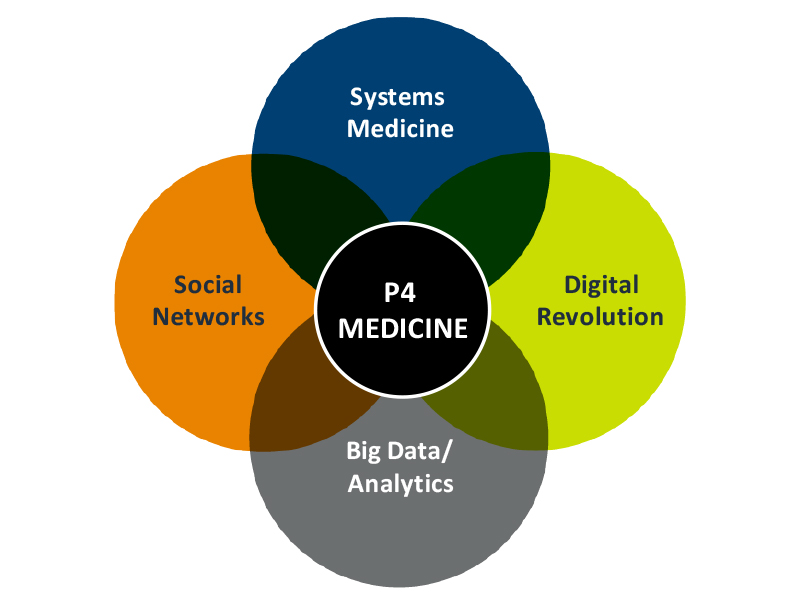
The concepts that emerged from systems approaches to disease have really evolved at ISB, all initially formulated in the first few years of our existence. Systems medicine is the systems approach (including new technologies and systems-driven strategies) to disease. This concept led to the idea that health care should be predictive, preventive, personalized and participatory (P4). Moreover, we realized that P4 health care should have two major thrusts — wellness and disease (wellness is almost entirely ignored by conventional 20th century medicine).
We further defined quantitative wellness by generating dense, longitudinal data clouds for individual humans that, when analyzed, led to actionable possibilities that could improve wellness and avoid or ameliorate disease, enable novel insights into mechanisms of wellness and disease, and provide new approaches to biomarker discovery and the identification of drug target candidates. We termed this quantitative wellness as “scientific wellness.”
The integration of a systems approach to disease, systems medicine, P4 health care and scientific wellness, collectively constitute the essence of the 21st Century Medicine which will improve the quality of health care, lead eventually to a reversal of all chronic diseases at their earliest transition points and enormously decrease the cost of health care. These conceptual formulations, including systems biology, have continued to evolve with the emergence of systems-driven technologies and strategies as well as computational tools and revolutionary new technologies (e.g., single-cell analyses). This evolution of thinking about systems biology and systems medicine has led to four ISB faculty members writing a textbook on this topic (see below).
Big Science Is Essential for Deciphering Complex Biological Systems
Big science — which is predicated on the idea that most interesting biological problems are complex and require the coordinated organization of many different scientific disciplines to tackle their complexity — has played an incredibly important role in ISB’s research agenda.
The Human Genome Project was biology’s first big science initiative. It required the coordination of teams of researchers from around the world engaged in sequencing DNA and developing the relevant technologies and computational tools necessary for delivering the first complete sequence of the human genome in 2003. It brought, for the first time, computer scientists and engineers into biology at a large scale. This project transformed the whole landscape of biology and it is beginning to impact medicine.
ISB has taken on a series of big science problems — preterm birth, the development of the technologies and systems-driven strategies of systems medicine, scientific wellness, The Cancer Genome Atlas (TCGA) project, and the sequence analysis of thousands of human genomes to characterize their general features and to correlate genetic variation with wellness or disease phenotypes. Each of these big science projects has required senior leadership and expertise, an implementation plan with timelines, the integration of both science and engineering techniques, and generation, correlation and interpretation of vast quantities of data. Often, we must deal with ethical and regulatory issues as well.
Big and small science are synergistic. Big science creates many opportunities for small science. Small science generally is a lab of 10 or fewer focused on a single or very limited set of problems. Big science creates hypotheses that can be tested by small science, as well as powerful new technologies and computational tools for facilitating small science (e.g. high throughput DNA sequencing) and the computational tools for data analysis.
Strategic Partnerships Are Often Critical in Helping Solve Big Problems
Big science quite naturally led to the emergence of strategic partnerships, which could bring together missing scientific and engineering talent, new technologies and strategies, collaborators to tackle difficult problems, and, in some cases, significant financial resources. All strategic partnerships require strong leadership and a clear science vision. I became convinced that bringing systems biology to institutions that desired 21st century science could provide that vision and at the same time create resources for ISB to invent the future of health care.
By 2005, ISB had pioneered the concept of P4 medicine. ISB sought partners who would participate in developing the systems-driven strategies and technologies of P4 medicine and eventually bring them to health care systems.
In 2005, I began exploring the possibility that countries might be interested in launching their own systems biology institutes and providing ISB with resources for carrying out this task. I started in Israel at the request of a fundraiser who was convinced he could raise $200 million, which would fund the building of an institute in Israel, and provide $100 million for ISB. I went to Israel twice and visited all the major academic institutions, making the pitch for a systems biology institute. Beersheba University had an outstanding president who was enthusiastic about this possibility and even initiated the design of a building to house the newly proposed institute. Unfortunately, the fundraiser was not successful and my first attempt at a strategic partnership ended in failure. In the next three years, I made similar pitches to agencies in Ireland, Korea and Alberta — and for distinct reasons each time the pitch failed. I had accumulated an enormous amount of experience on strategic partnership failures. After the Israel failure, the ISB board chair strongly suggested that I give up this “fruitless” search. But I persisted — determined optimism is essential for bringing new ideas and paradigms to reality.
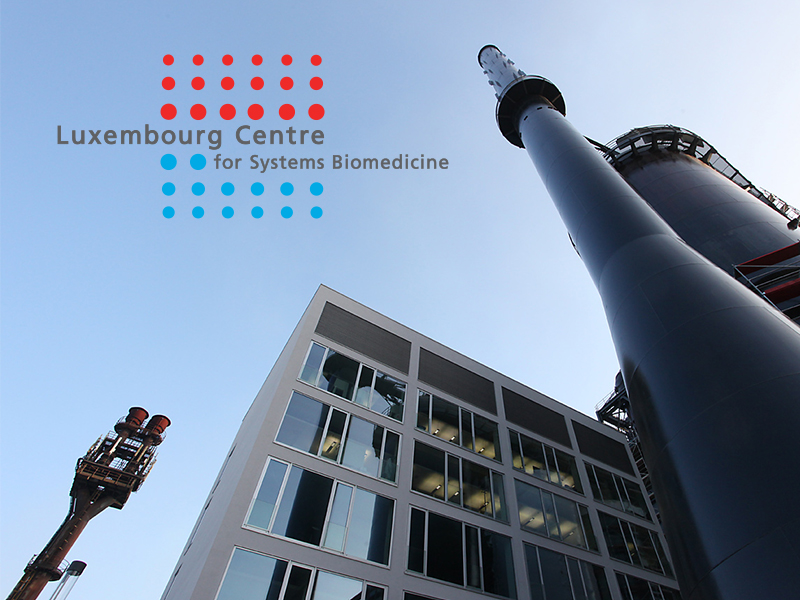
In 2007, I met the Minister of Economy for the Grand Duchy of Luxembourg, who was focused on diversifying its economy from a 90 percent dependence on financial services. His goal was to transform Luxembourg into a center of excellence in personalized medicine by investing heavily in the biotechnology sector. He invited ISB to submit a proposal to facilitate this objective — with no financial constraints.
We proposed to build a Luxembourg Center for Systems Biomedicine (LCSB) at the newly formed University of Luxembourg where ISB would recruit the director, help recruit faculty and train 11 postdoctoral fellows in the science and technologies of ISB who would return to LCSB. ISB faculty would collaborate with LCSB on science, technologies and computational biology and we also would create a network of outstanding, interacting scientists across the EU and U.S. to assist in this effort. We succeeded in these endeavors and today the Luxembourg Center for Systems Biomedicine is one of the leading life sciences institutions in the EU. This was done in about three years with the major contributions from ISB — and it could never have been done without ISB’s leadership. In return, we proposed that Luxembourg provide $100 million over five years for ISB to invent the technologies and strategies of P4 medicine. During the Luxembourg partnership, ISB pioneered 10 of these technologies and strategies.
This success with Luxembourg placed systems medicine at a tipping point in 2014, where we could clearly see how we could implement many aspects of P4 medicine in health care systems if we could find willing partners.
Scientific Wellness and the Emergence of Arivale
 Nathan Price and I then decided to pioneer and quantify scientific wellness and launched a pilot project with 108 individuals using personal, dense, dynamic data clouds over nine months. The 108 participants in this project were so enthusiastic about its outcomes that in 2015 we launched Arivale, a company that is bringing scientific wellness to consumers and industrial enterprises. Arivale now has 3,500 participants. ISB is partnering with Arivale using the de-identified data from these individuals for computational analyses of human wellness, and in a few cases, human disease. This is a marvelous example of how a spinoff company can play a major role in helping ISB realize and validate a big scientific objective — scientific wellness.
Nathan Price and I then decided to pioneer and quantify scientific wellness and launched a pilot project with 108 individuals using personal, dense, dynamic data clouds over nine months. The 108 participants in this project were so enthusiastic about its outcomes that in 2015 we launched Arivale, a company that is bringing scientific wellness to consumers and industrial enterprises. Arivale now has 3,500 participants. ISB is partnering with Arivale using the de-identified data from these individuals for computational analyses of human wellness, and in a few cases, human disease. This is a marvelous example of how a spinoff company can play a major role in helping ISB realize and validate a big scientific objective — scientific wellness.
ISB-PSJH Affiliation Opens the Possibility of Bringing P4 Health Care and 21st Century Medicine to a Large Health Care System
Late in 2015, Rod Hochman, M.D., CEO of the large non-profit Providence Health Systems (now Providence St. Joseph Health), approached me with a striking proposition. He suggested that ISB become the research arm of Providence and that I serve as Providence’s chief science officer. He understood the power of scientific wellness and was sympathetic to the vision of 21st Century Medicine. In a moment, I realized that this was a pathway to bringing P4 medicine to the U.S. health care system. Indeed, over the preceding 5-6 years, I had approached six top ranked academic medical institutions — including my alma mater, Johns Hopkins. I generally pitched the idea of ISB helping the institution build a Systems Medicine Center as we did with Luxembourg. Bureaucracy, scientific silos and a commitment to 20th rather than 21st century objectives in various combinations led all to decline our offers. I don’t think any of them realized how profoundly systems thinking had changed medicine and opened the way for 21st Century Medicine. So, it was exhilarating to find that a large non-profit community health care system could enthusiastically embrace P4 health care and systems medicine. In April of 2016, ISB and Providence signed an affiliation agreement to connect ISB’s systems approaches to medicine with the clinical expertise at PSJH to begin to shift health care delivery from a predominately disease focus to a wellness focus with powerful strategies for prediction and prevention.

Providence did not have a formal, overarching research organization in place prior to the affiliation — although it did have outstanding scientist-clinicians at many of its 50 hospitals and two cancer research centers. Over the last 18 months, I have given 25 lectures for Providence leaders, scientists and clinicians, introducing the idea that systems-driven research, properly supported, will enable PSJH to invent the future of health care. I created a Scientific Advisory Council of 23 members drawn from PSJH and ISB scientists and clinicians to develop a strategic vision for research in PSJH.
Nathan Price and I are creating a Center for Translational Systems Medicine (CTSM) to enable a powerful interface between ISB and PSJH. CTSM has identified 10 translational pillars (clinical trials using systems approaches and personal, dense, dynamic data clouds), a technology platform to create these data clouds, specialty clinics for scientific wellness and Alzheimer’s Disease, and an educational program to bring the vision of 21st Century Medicine to students, patients, MDs in training and health care professionals.
PSJH is the first (and currently the only) health care system beginning to practice systems-driven 21st Century Medicine. Together PSJH and ISB will be among those inventing the future of health care — both nationally and eventually globally.
ISB Faculty Are Diverse in Skills and Interests
The ISB faculty are a remarkable collection of individuals with broad skills and unique orientations.
John Aitchison is an outstanding systems cell biologist with an interest in big and challenging problems such as nuculear transport. He has also developed powerful technologies that focus on cells.
Nitin Baliga is a systems microbiologist and computational biologist with broad and diverse interests in the environment and medicine who has pioneered marvelous tools to reveal the secrets of biological networks. He has also pioneered some remarkable programs for the education of K-12 students in systems biology and food production.
Sui Huang is a marvelous conceptual thinker with an interest in using single-cell analyses to decipher the complexities of biology and disease. He is demonstrating that many of our previous convictions about cancer are totally wrong.
Robert Moritz is a skilled protein chemist with a broad and comprehensive focus on developing proteome technologies to define the proteomes of cells, organs and organisms to, in the case of humans, search for biomarkers and even drug and vaccine targets.
Nathan Price is a superb computational biologist with an interest in metabolism, transcriptional networks, scientific wellness and 21st Century Medicine. He is pioneering the development of the Center for Translational Systems Medicine to serve as an interface between ISB and PSJH.
Jeff Ranish is an accomplished protein chemist working on cross-linking reagents for protein complexes that are helping delineate the structure of complex, multi-sub-unit proteins and one day will even delineate biological networks.
Ilya Shmulevich is a brilliant engineer with an interest in signal processing, large-scale computing and large-scale modeling whose skills have been focused largely on cancer through The Cancer Genome Atlas project.
Naeha Subramanian is a systems immunologist and molecular biologist interested in immunity and its impact on infectious diseases such as Lyme Disease. Naeha is an exceptional scientist with enormous promise to be one of the leaders in a systems approach to immunology.
Scientific papers
I want to highlight some of the most important papers that I have co-authored over my past 17 years with ISB, as they reflect both the fundamental contributions to systems biology, a systems approach to disease or systems-driven technologies/strategies as well as the evolution of our conceptual thinking about systems biology, systems medicine, P4 health care and scientific wellness:
- A review which defined the fundamental principles of systems biology in 2001 that remain valid today
- Creation of the Cytoscape algorithm in 2001 — graphical construction of networks from biological data — one of the most widely used algorithms today in computational biology
- A study in 2001 of how dynamical networks explain yeast galactose metabolism — this was the first application of a systems approach to explain a biological mechanism
- A study in 2007 of how dynamical network analyses allows one to predict the responses of a single celled organism, halobacterium, to changes in its environment — a milestone in predictive systems thinking pioneered by Nitin Baliga
- A study in 2009 of how dynamical networks explain prion-induced neurodegeneration in mice — which opened an entirely new approach to demystifying disease
- In 2010 and in 2016, we pioneered family genome sequencing which allows one to identify disease-genes — for both simple diseases and complex diseases like bipolar disorders
- A series of papers conceptually and practically defining systems medicine, P4 health care and scientific wellness from 2003 through 2017
- Several papers on the use of systems approaches to biomarker discovery, which allowed one to create diagnostic lung cancer and preterm birth protein blood panels — tests that are being used in clinical practice today from 2014 through 2017
- Quantifying scientific wellness with personal, dense, dynamic data clouds, which when analyzed lead to actionable possibilities that allow one to optimize wellness and avoid disease (2017). These data will also transform how pharma, diagnostic companies and nutrition companies will carry out their work in the future
- The 2016 ISB Annual Report on how 21st Century Medicine, constituted of P4 health care, systems medicine and scientific wellness, will transform health care in the future
- A text book on systems biology and systems medicine with ISB faculty members Sui Huang, Nathan Price and Ilya Shmulevich
ISB colleagues I value
In science, Nathan Price and Jim Heath (who succeeded me as president) have been long-term and exciting collaborators, and the entire ISB faculty has enlightened me in so many ways. I also want to acknowledge Eric Davidson, who died last year. He was my closest friend and scientific colleague both at Caltech and the years after. Eric pioneered the most comprehensive and informative systems approach to understanding early development in any organism — in the sea urchin. Lee Rowen has been wonderful as a science partner since our days working together at Caltech — she is often willing to tell me what others would not. Allison Kudla was a teriffic partner in our Consilience (grand unification of humanities, social science and science a la E.O.Wilson) Programs, and she works artistic magic with documents and PowerPoint slides. Ginny Ruffner is the artist responsible for all of the fascinating sculptures that decorate the first, third and fourth floors of ISB — and has a passion for integrating art and biology with ISB scientists. Gretchen Sorensen has taught me much about the world of politics and how to position organizations for success with funders and other key stakeholders. Kathy Scanlan has been a marvelous ISB COO — smart, strategic, effective at dealing with bureaucracies, selfless and a wonderful administrative leader. Sheryl Suchoknand has been invaluable in managing the complexities of my life and in providing insights into the complexities of PSJH at which she worked for many years. Roger Perlmutter was ISB’s first board chair and he guided us through the early years, which were quite challenging. He continues to be a wonderful source of insights — both scientific and beyond. Dave Sabey is a visionary leader and he has been an outstanding ISB board chair and a good friend. Craig Mundie has been a good friend, a wise counselor and perhaps the best board member I have seen for taking fascinating and often surprising points of view. Aron Thompson has provided wise financial counsel both for me and ISB. He has also contributed significantly to ISB’s Valerie Logan Center for Education. Mauricio Flores and Qiang Tian helped with the conceptualization and now the applications of the P4 Medicine Institute to patients and physicians — and together we initiated numerous, still unrealized attempts to create a viable Chinese strategic partnership on P4 health care. Clayton Lewis is the most incredible CEO I have worked with and known — and building Arivale with Clayton has been a fascinating experience with a company that will bring scientific wellness to the world. Finally, Valerie Logan has been my wife and partner in all aspects of my life for more than 50 years. She was primarily responsible for initiating our diverse efforts in K-12 science education — and the naming of the Valerie Logan Center for Education is a testimony to her enormous contributions.
Coda
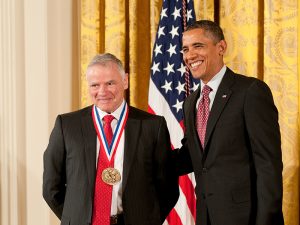
Dr. Hood is pictured with President Barack Obama during a 2013 White House ceremony after receiving the National Medal of Science.
As you can see, ISB has been a far more exciting adventure than I ever could have imagined. It changed my entire perspective on science and medicine and how we can transform the future. And the future looks even brighter than this very exciting past. We will change the health care system to 21st Century Medicine (the big question is how long this will take). I continue to learn from this adventure and I continue to have fun in all dimensions of my life. Those are the secrets of eternal youth (plus exercise!).





